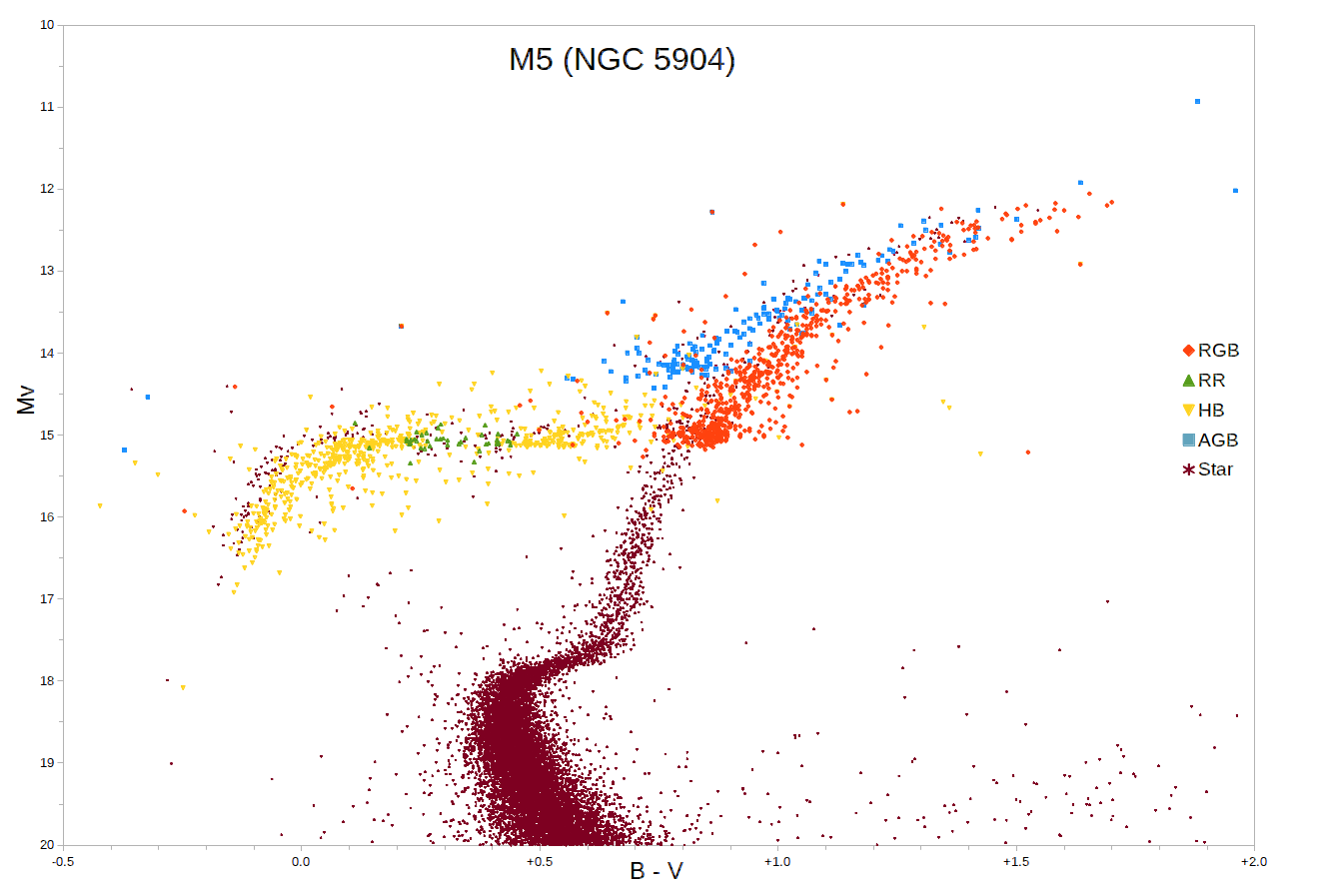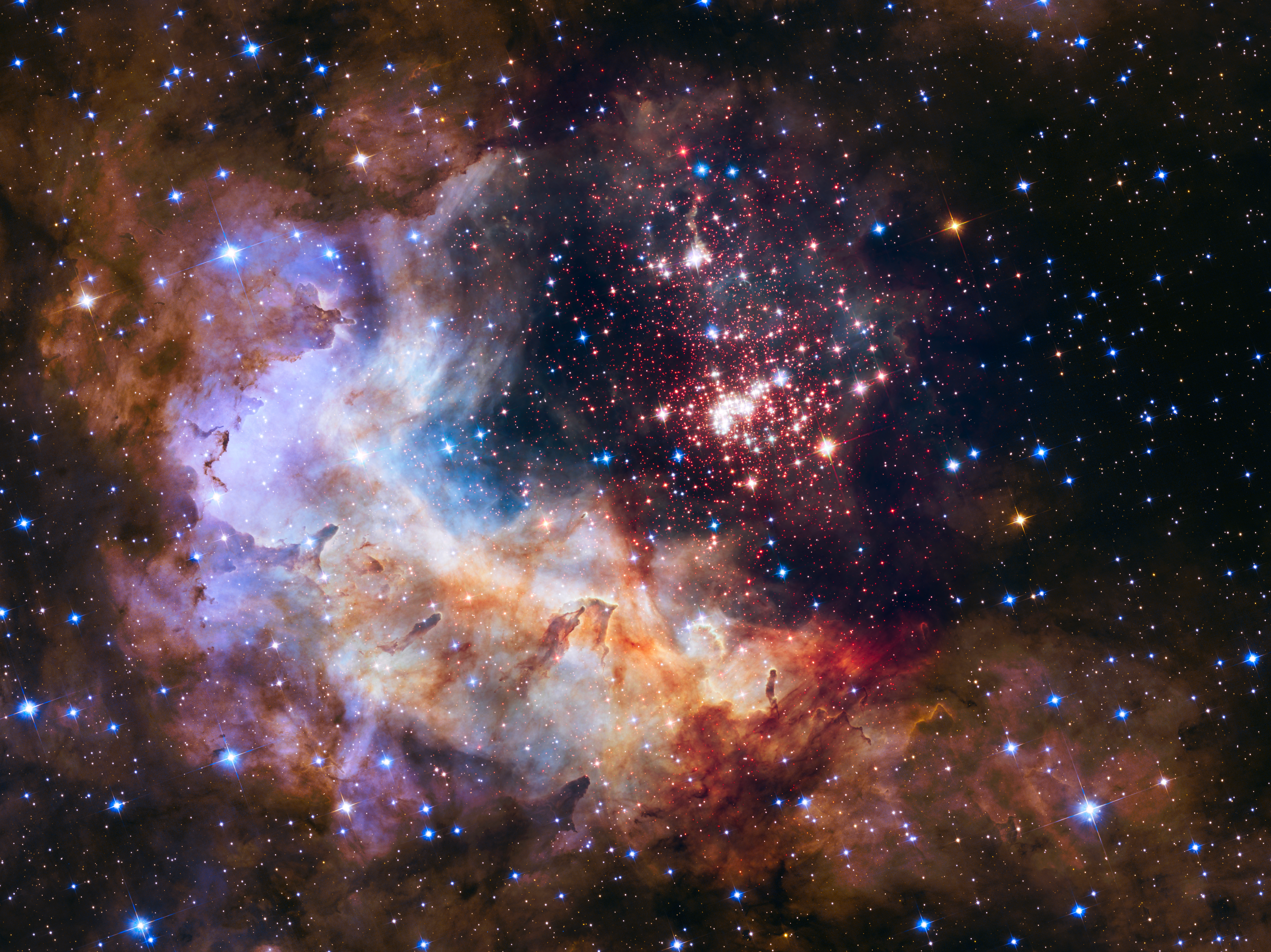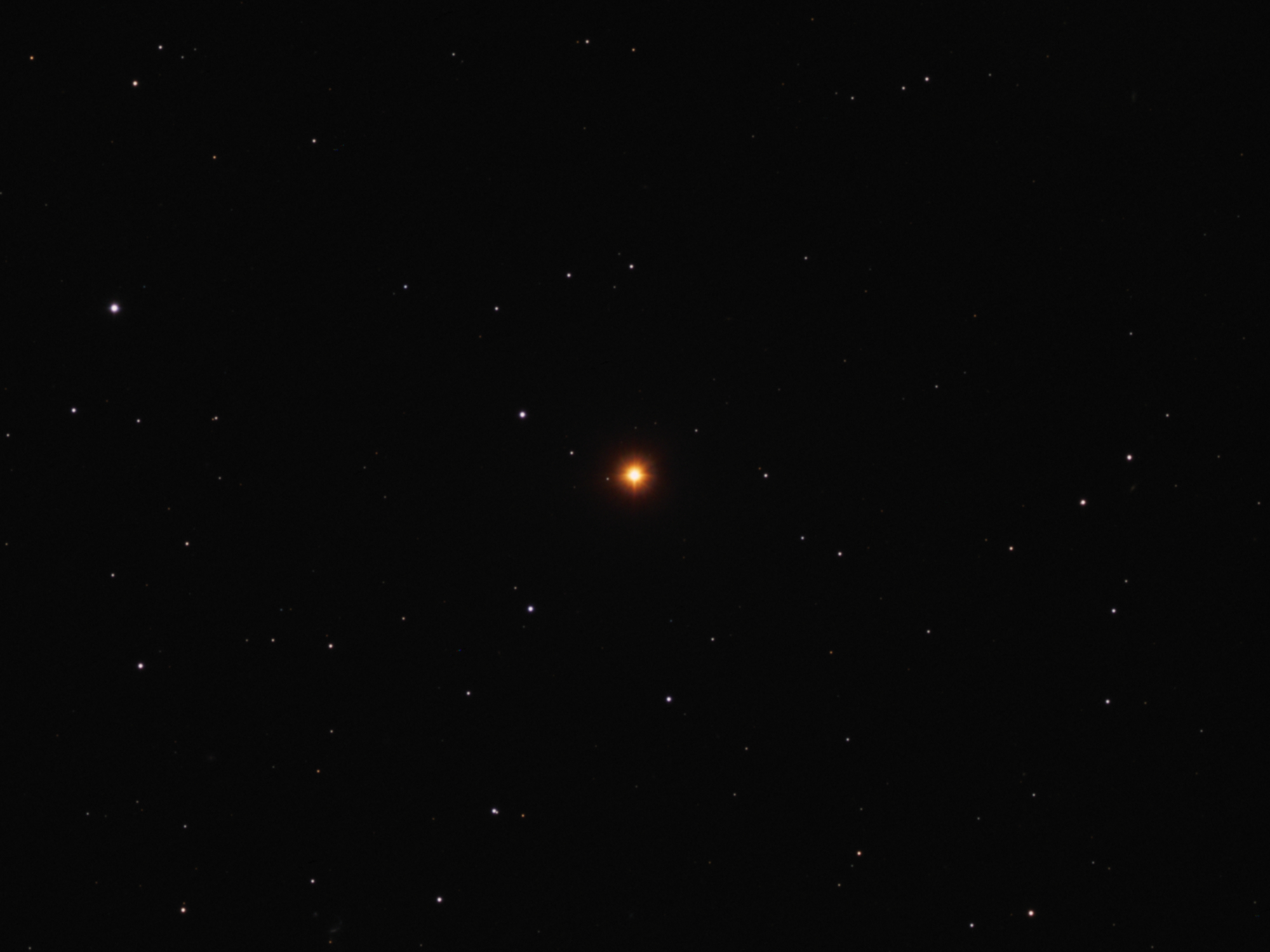|
Asymptotic-giant-branch
The asymptotic giant branch (AGB) is a region of the Hertzsprung–Russell diagram populated by evolved cool luminous stars. This is a period of stellar evolution undertaken by all low- to intermediate-mass stars (about 0.5 to 8 solar masses) late in their lives. Observationally, an asymptotic-giant-branch star will appear as a bright red giant with a luminosity ranging up to thousands of times greater than the Sun. Its interior structure is characterized by a central and largely inert core of carbon and oxygen, a shell where helium is undergoing fusion to form carbon (known as helium burning), another shell where hydrogen is undergoing fusion forming helium (known as hydrogen burning), and a very large envelope of material of composition similar to main-sequence stars (except in the case of carbon stars). Stellar evolution When a star exhausts the supply of hydrogen by nuclear fusion processes in its core, the core contracts and its temperature increases, causing the outer lay ... [...More Info...] [...Related Items...] OR: [Wikipedia] [Google] [Baidu] |
Stellar Evolution
Stellar evolution is the process by which a star changes over the course of time. Depending on the mass of the star, its lifetime can range from a few million years for the most massive to trillions of years for the least massive, which is considerably longer than the current age of the universe. The table shows the lifetimes of stars as a function of their masses. All stars are formed from Gravitational collapse, collapsing clouds of gas and dust, often called nebulae or molecular clouds. Over the course of millions of years, these protostars settle down into a state of equilibrium, becoming what is known as a main sequence star. Nuclear fusion powers a star for most of its existence. Initially the energy is generated by the fusion of hydrogen atoms at the stellar core, core of the main-sequence star. Later, as the preponderance of atoms at the core becomes helium, stars like the Sun begin to fuse hydrogen along a spherical shell surrounding the core. This process causes the st ... [...More Info...] [...Related Items...] OR: [Wikipedia] [Google] [Baidu] |
Red Giant
A red giant is a luminous giant star of low or intermediate mass (roughly 0.3–8 solar masses ()) in a late phase of stellar evolution. The stellar atmosphere, outer atmosphere is inflated and tenuous, making the radius large and the surface temperature around or lower. The appearance of the red giant is from yellow-white to reddish-orange, including the stellar classification, spectral types K and M, sometimes G, but also S-type star, class S stars and most carbon stars. Red giants vary in the way by which they generate energy: * most common red giants are stars on the red-giant branch (RGB) that are still stellar nucleosynthesis, fusing hydrogen into helium in a shell surrounding an inert helium core * red-clump stars in the cool half of the horizontal branch, fusing helium into carbon in their cores via the triple-alpha process * asymptotic-giant-branch (AGB) stars with a helium burning shell outside a degenerate carbon–oxygen core, and a hydrogen-burning shell just beyo ... [...More Info...] [...Related Items...] OR: [Wikipedia] [Google] [Baidu] |
M5 Colour Magnitude Diagram
M5, M-5, M.5, M-V, or M05 may refer to: Transportation Automobiles * AITO M5, a Chinese mid-size crossover SUV * BMW M5, a German mid-size performance car series * Dongfeng Fengxing Lingzhi, Dongfeng Fengxing Lingzhi M5, a Chinese MPV * Haima M5, a Chinese compact sedan * JAC Refine M5, a Chinese MPV * Studebaker M5, an American pickup truck Aviation and aerospace * M-5 rocket, a Japanese rocket * Macchi M.5, an Italian flying boat fighter in service from 1917 until the mid-1920s * Miles M.5 Sparrowhawk, a 1930s British single-seat racing and touring monoplane * Fokker M.5, a 1913 unarmed single-seat monoplane aircraft * Grigorovich M-5, a Russian World War I-era biplane flying boat * Kenmore Air (IATA airline designator: M5), a small airline based in the United States Military * M5 Stuart, a variant of the Stuart tank, a World War II-era American light tank * M5 half-track, a variant of the M3 Half-track military armored personnel carrier * M5 tractor, World War II-era artiller ... [...More Info...] [...Related Items...] OR: [Wikipedia] [Google] [Baidu] |
Population II Stars
In 1944, Walter Baade categorized groups of stars within the Milky Way into stellar populations. In the abstract of the article by Baade, he recognizes that Jan Oort originally conceived this type of classification in 1926. Baade observed that bluer stars were strongly associated with the spiral arms, and yellow stars dominated near the central galactic bulge and within globular star clusters. Two main divisions were deemed ''populationI'' and ''populationII stars'', with another newer, hypothetical division called ''populationIII'' added in 1978. Among the population types, significant differences were found with their individual observed stellar spectra. These were later shown to be very important and were possibly related to star formation, observed kinematics, stellar age, and even galaxy evolution in both spiral and elliptical galaxies. These three simple population classes usefully divided stars by their chemical composition, or ''metallicity''. In astrophysics nomen ... [...More Info...] [...Related Items...] OR: [Wikipedia] [Google] [Baidu] |
Stellar Mass Loss
Stellar mass loss is a phenomenon observed in stars by which stars lose some mass over their lives. Mass loss can be caused by triggering events that cause the sudden ejection of a large portion of the star's mass. It can also occur when a star gradually loses material to a binary companion or due to strong stellar winds. Massive stars are particularly susceptible to losing mass in the later stages of evolution. The amount and rate of mass loss varies widely based on numerous factors. Stellar mass loss plays a very important role in stellar evolution, the composition of the interstellar medium, nucleosynthesis as well as understanding the populations of stars in clusters and galaxies. Causes Every star undergoes some mass loss in its lifetime. This could be caused by its own stellar wind, or by interactions with the outside environment. Additionally, massive stars are particularly vulnerable to significant mass loss and can be influenced by a number of factors, including: * Gr ... [...More Info...] [...Related Items...] OR: [Wikipedia] [Google] [Baidu] |
Long-period Variable
The descriptive term long-period variable star refers to various groups of cool luminous pulsating variable stars. It is frequently abbreviated to LPV. Types of variation The General Catalogue of Variable Stars does not define a long-period variable star type, although it does describe Mira variables as long-period variables. The term was first used in the 19th century, before more precise classifications of variable stars, to refer to a group that were known to vary on timescales typically hundreds of days. By the middle of the 20th century, long period variables were known to be cool giant stars. The relationship of Mira variables, semiregular variables, and other pulsating stars was being investigated and the term ''long period variable'' was generally restricted to the coolest pulsating stars, almost all Mira variables. Semiregular variables were considered intermediate between LPVs and Cepheids. After the publication of the General Catalogue of Variable Stars, both Mira ... [...More Info...] [...Related Items...] OR: [Wikipedia] [Google] [Baidu] |
Carbon Star
A carbon star (C-type star) is typically an asymptotic giant branch star, a luminous red giant, whose Stellar atmosphere, atmosphere contains more carbon than oxygen. The two elements combine in the upper layers of the star, forming carbon monoxide, which consumes most of the oxygen in the atmosphere, leaving carbon atoms free to form other carbon compounds, giving the star a "sooty" atmosphere and a strikingly Ruby (color), ruby red appearance. There are also some dwarf and supergiant carbon stars, with the more common giant stars sometimes being called classical carbon stars to distinguish them. In most stars (such as the Sun), the atmosphere is richer in oxygen than carbon. Ordinary stars not exhibiting the characteristics of carbon stars but cool enough to form carbon monoxide are therefore called oxygen-rich stars. Carbon stars have quite distinctive stellar classification, spectral characteristics, and they were first recognized by their spectra by Angelo Secchi in the 186 ... [...More Info...] [...Related Items...] OR: [Wikipedia] [Google] [Baidu] |
S-process
The slow neutron-capture process, or ''s''-process, is a series of nuclear reactions, reactions in nuclear astrophysics that occur in stars, particularly asymptotic giant branch stars. The ''s''-process is responsible for the creation (nucleosynthesis) of approximately half the Atomic nucleus, atomic nuclei Heavy metal (chemical element), heavier than iron. In the ''s''-process, a seed nucleus undergoes neutron capture to form an isotope with one higher atomic mass. If the new isotope is stable nuclide, stable, a series of increases in mass can occur, but if it is unstable nucleus, unstable, then beta decay will occur, producing an element of the next higher atomic number. The process is ''slow'' (hence the name) in the sense that there is sufficient time for this radioactive decay to occur before another neutron is captured. A series of these reactions produces stable isotopes by moving along the valley of stability, valley of beta-decay stable isobars in the table of nuclides. ... [...More Info...] [...Related Items...] OR: [Wikipedia] [Google] [Baidu] |
Evolution On The TP-AGB
Evolution is the change in the heritable characteristics of biological populations over successive generations. It occurs when evolutionary processes such as natural selection and genetic drift act on genetic variation, resulting in certain characteristics becoming more or less common within a population over successive generations. The process of evolution has given rise to biodiversity at every level of biological organisation. The scientific theory of evolution by natural selection was conceived independently by two British naturalists, Charles Darwin and Alfred Russel Wallace, in the mid-19th century as an explanation for why organisms are adapted to their physical and biological environments. The theory was first set out in detail in Darwin's book ''On the Origin of Species''. Evolution by natural selection is established by observable facts about living organisms: (1) more offspring are often produced than can possibly survive; (2) traits vary among individuals with ... [...More Info...] [...Related Items...] OR: [Wikipedia] [Google] [Baidu] |
Astronomy And Astrophysics
''Astronomy & Astrophysics (A&A)'' is a monthly peer-reviewed scientific journal covering theoretical, observational, and instrumental astronomy and astrophysics. It is operated by an editorial team under the supervision of a board of directors representing 27 sponsoring countries plus a representative of the European Southern Observatory. The journal is published by EDP Sciences and the current editors-in-chief are Thierry Forveille and João Alves. History Origins ''Astronomy & Astrophysics'' was created as an answer to the publishing situation found in Europe in the 1960s. At that time, multiple journals were being published in several countries around the continent. These journals usually had a limited number of subscribers, and articles were written in languages other than English. They were less widely read than American and British journals and the research they reported had therefore less impact in the community. Starting in 1963, conversations between astronomers from ... [...More Info...] [...Related Items...] OR: [Wikipedia] [Google] [Baidu] |
Helium Flash
A helium flash is a very brief thermal runaway nuclear fusion of large quantities of helium into carbon through the triple-alpha process in the core of low-mass stars (between 0.5-0.44 solar masses () and 2.0 ) during their red giant phase. The Sun is predicted to experience a flash 1.2 billion years after it leaves the main sequence. A much rarer runaway helium fusion process can also occur on the surface of Accretion (astrophysics), accreting white dwarf stars. Low-mass stars do not produce enough gravity, gravitational pressure to initiate normal helium fusion. As the hydrogen in the core is exhausted, some of the helium left behind is instead compacted into degenerate matter, supported against gravitational collapse by quantum mechanics, quantum mechanical pressure rather than ideal gas law, thermal pressure. Subsequent hydrogen shell fusion further increases the mass of the core until it reaches temperature of approximately 100 million kelvin, which is hot enough to initiate ... [...More Info...] [...Related Items...] OR: [Wikipedia] [Google] [Baidu] |
Astronomical Unit
The astronomical unit (symbol: au or AU) is a unit of length defined to be exactly equal to . Historically, the astronomical unit was conceived as the average Earth-Sun distance (the average of Earth's aphelion and perihelion), before its modern redefinition in 2012. The astronomical unit is used primarily for measuring distances within the Solar System or around other stars. It is also a fundamental component in the definition of another unit of astronomical length, the parsec. One au is approximately equivalent to 499 light-seconds. History of symbol usage A variety of unit symbols and abbreviations have been in use for the astronomical unit. In a 1976 resolution, the International Astronomical Union (IAU) had used the symbol ''A'' to denote a length equal to the astronomical unit. In the astronomical literature, the symbol AU is common. In 2006, the International Bureau of Weights and Measures (BIPM) had recommended ua as the symbol for the unit, from the French ... [...More Info...] [...Related Items...] OR: [Wikipedia] [Google] [Baidu] |








